Do you have an emergency kit in your vehicle?
Disaster never lets you know ahead of time when it’s going to strike. In most cases, a person is out doing what they do every single day, like driving to or from work, when an emergency occurs. Sometimes people are on a recreational outing. Whatever the case, it pays to be prepared. This can de-escalate a potentially life-threatening crisis down to an inconvenience.
I’ve written about a couple of incidents recently that resulted in people being stranded with only the supplies in their vehicles. Last winter, a family was stranded for days in the frigid wilderness of the Nevada mountains during subzero temperatures. More recently, a freak snow storm hit the Atlanta, Georgia area causing a gridlock that left many travellers trapped in their vehicles overnight.
But don’t think the kit is necessary only during cold weather. Accidents happen at all times of year, and no matter what the season, your survival, or at the very least, your comfort, can hinge on having food, drinks, light, tools, and appropriate clothing.
Each article contained a lengthy list for an emergency kit. My favorite comment on the article had to be this one:
Where would you fit all of this stuff unless you were driving a tank-sized vehicle?
or maybe this one:
Just one question: Where do the vehicle’s occupants ride?
Since I thought those were excellent questions, I took some photos when I switched yesterday from my cold weather emergency kit to my warm weather kit. This is how I manage to fit everything into my vehicle. I drive a small SUV.
First, I use small containers to store individual components of the kit.
Tools and First Aid
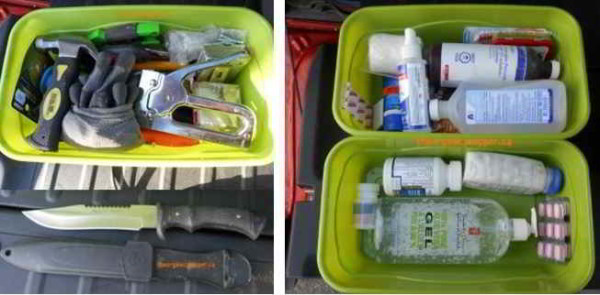
I use old Altoids containers for small items like band-aids and alcohol wipes. They stand up far better than the flimsy cardboard boxes those items come in.
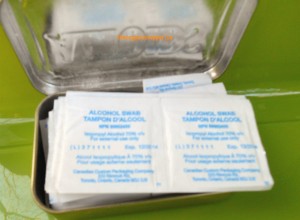
Light and Individual Kits
The police flashlight is also a taser.
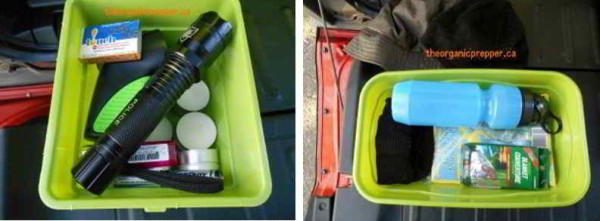
It’s sort of hard to see but above the container is a stocking hat for warmth and a waterproof hat that will also provide some sun protection. Inside the container are two pairs of socks, a rain poncho, a Berkey sport bottle (it can purify up to 100 gallons of water) and a space blanket. Each of these is topped off with a hoodie in warmer weather. In the winter, gloves and scarves replace the hoodie.
Shelter
Obviously, this is not the Taj Mahal of tents. But it fits easily into a backpack and would be sufficient for day-to-day emergencies in warmer weather. In winter, and anytime we are going further from home, we have a bigger sturdier tent that we put in the vehicle.
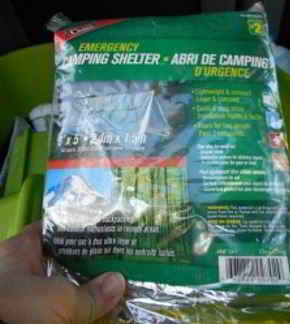
Emergency Kit
All of the above mini-kits go into one big 18 gallon tote.
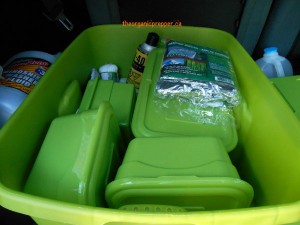
Also included are a few different types of rope, a compass, a road atlas of North America, WD-40, duct tape, and a 4 pack of toilet paper. There is room for 2 blankets folded on top.
Food
I use a separate smaller container for food and hygiene items.
Our food kit contains graham crackers with peanut butter, pop-top cans of soup, poptop cans of fruit, antiseptic wipes, hand sanitizer, baby wipes, garbage bags, spoons, forks, a survival guide, and plastic dishes. Not shown: ziplock bags of dog food in single servings.
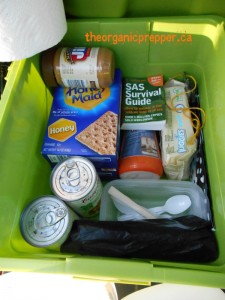
I got these dog dishes that flatten out completely at the dollar store. I also use them when I take my dog hiking – it is a no-space way to conveniently keep her hydrated and it doesn’t add extra weight to my back pack. In a pinch, they could be used for human food also.
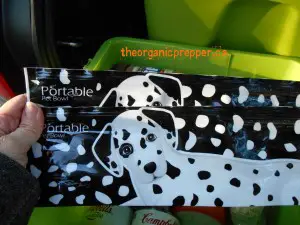
Shoes
The second large tote in the back is a lot fuller in the winter. I leave it back there year-round because it keeps the other container from sliding around and it makes a good container for shopping bags and small items that I am transporting. I leave the lid off this container and use it for things like groceries or library books. In the winter, it holds winter hiking boots, snow pants, and extra blankets but there is still a little space on top for shopping bags. I can’t emphasize enough the importance of having sturdy, comfortable footwear.
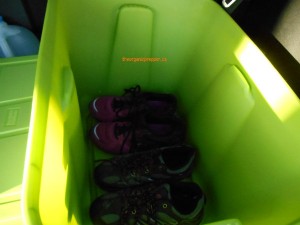
Notes
- Not shown: My vehicle has space beneath the back seats, where we store tightly rolled sleeping bags. If I didn’t have this space, I’d be able to put them in the tote that holds the shoes.
- Because of extreme temperature fluctuations throughout the year, the food should be rotated out of the vehicle every couple of months so that you always have fresh food available.
- In cold weather, your water bottles should have about 2 inches of the water removed to allow room for expansion when the contents freeze.
- Always have a backpack for each family member. If you are forced by circumstances to leave your vehicle on foot, you want to be able to carry as much of your gear as possible.
- Depending on the laws in your state (and your interest in complying with them) weapons and ammunition can be very useful additions to your vehicle kit.
- Your kit should change with the seasons. Snow pants won’t do you much good in the heat of summer, but extra water will be invaluable.
- When taking a longer trip, add more food and water to your kit than you might normally keep in it.
List
Not every person needs every item on this list. Pick and choose the items that are important given your family situation, your environment, and your most-likely disaster scenarios. No list can be comprehensive for every person but this one has served us well.
- Backpacks
- Sleeping bags
- Tent
- Lighter, flint, waterproof matches
- Lighter fluid (this can help start a fire even in damp conditions)
- Candles
- Hunting Knife
- Compass
- Pocket Survival book
- Signal flares
- Space blankets
- Atlas
- Flashlight
- Extra batteries
- Lantern
- Mirrors for signalling
- Whistles for making noise to help rescuers find you
- Crackers
- Peanut butter
- Canned stew or chili
- Canned baked beans
- Canned fruit
- Cookies
- Granola Bars
- A few gallons of water
- Berkey-to-go for each family member (or other portable filtration device)
- Bandages
- Gauze
- Pain relief pills
- Antibiotic cream
- Allergy medication and an Epi-pen (My daughter has a food allergy)
- Motion sickness medication
- Alcohol wipes
- Anti-diarrheal medication
- Rubbing alcohol
- Hydrogen peroxide
- Basic automotive repair tools
- Hammer
- Prybar
- Assorted screwdrivers
- Pliers
- Hacksaw
- Rope
- Paracord
- Bungee cords
- Duct tape
- Lubricant like WD-40
- Seasonally appropriate clothing
- Snow pants
- Coats
- Long underwear
- Socks
- Gloves
- Hats
- Sturdy, comfortable walking boots
Other Resources:
Packing Survival Junk in Your Trunk
15 Items That Should Be in Your Vehicle During the Winter
Be Ready with Vehicle 72 Hour Kits
Please feel free to share any information from this site in part or in full, giving credit to the author and including a link to this website and the following bio.
Daisy Luther is a freelance writer and editor. Her website, The Organic Prepper, offers information on healthy prepping, including premium nutritional choices, general wellness and non-tech solutions. You can follow Daisy on Facebook and Twitter, and you can email her at daisy@theorganicprepper.ca
– See more at: https://www.theorganicprepper.ca/how-to-create-a-vehicle-emergency-kit-03112014#sthash.WWyZCanp.dpuf

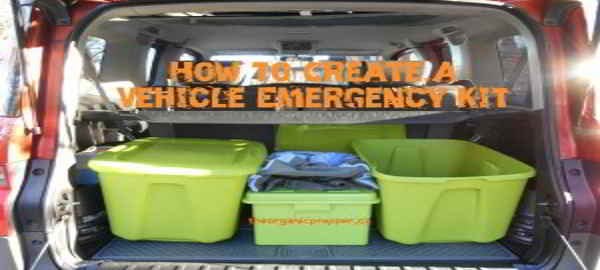




















x-tra knives as they break